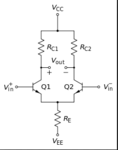parkpika
Junior Member level 3

- Joined
- Jun 18, 2013
- Messages
- 26
- Helped
- 0
- Reputation
- 0
- Reaction score
- 0
- Trophy points
- 1
- Location
- parkpika
- Activity points
- 183
Opamp configuration
I have a very basic question about opamps. Say we have an integrator, using R and C.

The equivalent model for the opamp is,

If I take the second figure and add R and C and ground one of the diff pair, does it still function as an integrator? If so, do people just use the first picture because it is easier to see?
Is it implied that Vo in the first picture is Vo1-Vo2?
I have a very basic question about opamps. Say we have an integrator, using R and C.

The equivalent model for the opamp is,

If I take the second figure and add R and C and ground one of the diff pair, does it still function as an integrator? If so, do people just use the first picture because it is easier to see?
Is it implied that Vo in the first picture is Vo1-Vo2?
Last edited:

